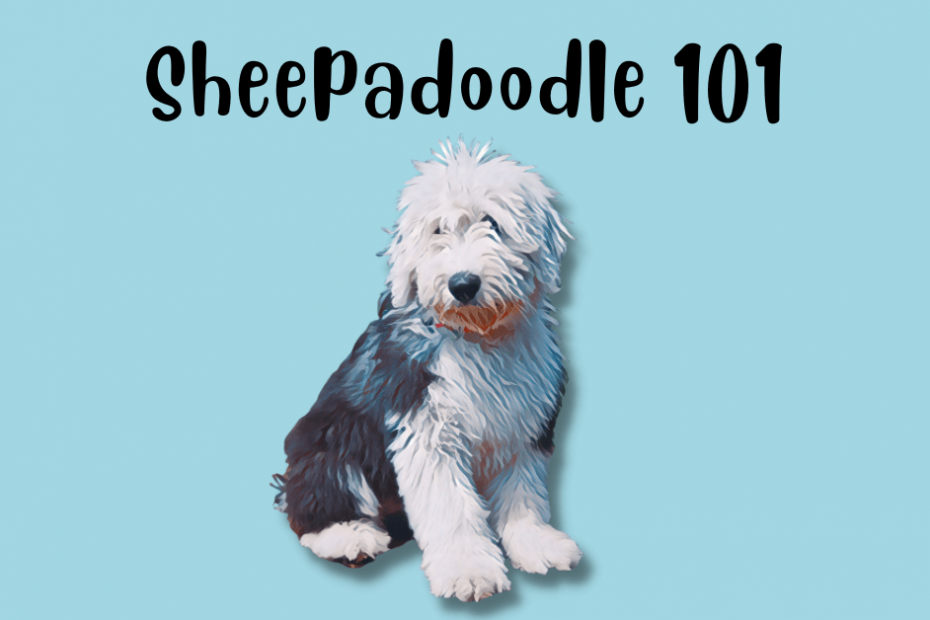The Sheepadoodle is a mix between an Old English Sheepdog and a Poodle.
They are a designer breed that was the brainchild of the U.S Army. Eventually, breeders saw an opportunity to breed a big fluffy companion dog that was easy on allergy sufferers and a good fit for most households.
If you want a dog that has a low-maintenance coat and won’t flare up your allergies, the Sheepadoodle might be right for you. In this in-depth look at this hybrid cross-breed, you will learn more about the origins and other helpful information on this beautiful big dog breed.
Introduction To Sheepadoodles
Sheepadoodles have big prominent personalities. They are a hybrid breed; a hybrid is a cross between two purebred parents. The Sheepadoodle is a cross between an Old English Sheepdog and a Standard Poodle, giving breeders and owners the best of both worlds.
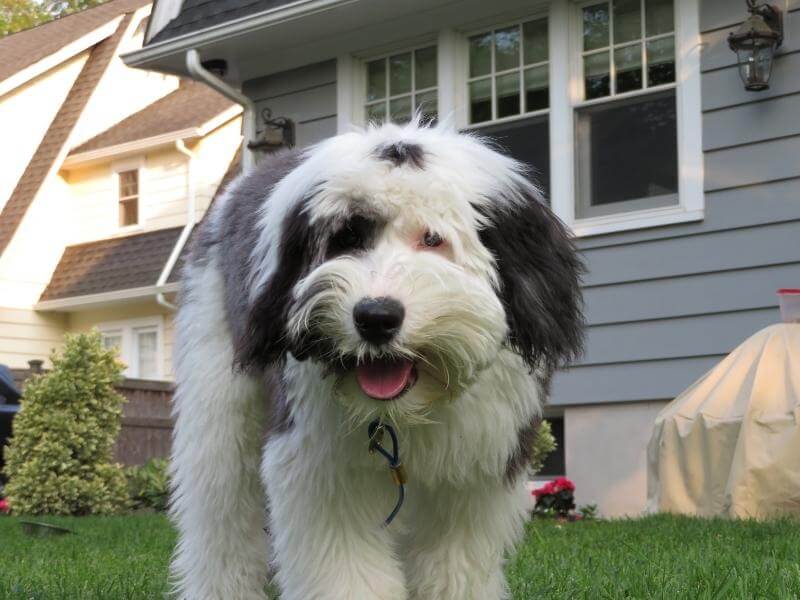
They are not to be confused with Shepadoodles, which is a German Shepard crossed with a Poodle. The usage of one e versus two e‘s makes a difference!
If you don’t believe me when I say these pups are goofy fluff balls, then check out the adorable Izzy the Sheepadoodle below:
[lyte id=’NoVNgKoKv00′ /]
Popularity in Modern Culture
Sheepadoodles are designer dogs that are fun to be around and love to be goofy. The Sheepadoodle has become more popular since the 1980s as breeders saw the potential of a big fluffy dog with a low shedding coat.
Breeders also realized that Sheepadoodles are very in tune with the emotions of humans. Their sensitivity and adaptability to human emotions mean they can sense an emotional change in their owners. Since then, they have often been used as emotional support and therapy dogs.
A History that started in the Military
There is a possibility that some Sheepadoodles existed naturally through accidental breeding, as the records on that are murky. Still, the first time people purposefully bred Sheepadoodles was in the 1960s by the U.S. military. The military bred Old English Sheepdogs with Standard Poodles.
They intended to breed a dog that worked well with troops that suffered from allergies. The curly coat of the Poodle is low to non-shedding, making it a good dog for those who don’t want to aggravate their allergies.
It is rare to find Sheepadoodles in the U.K. as the number of Old English Sheepdogs is declining, and the breeding clubs are trying to save the breed. So there are fewer cross-breeds that have Old English Sheepdogs as one parent [1]www.purina.co.uk/find-a-pet/dog-breeds/sheepadoodle.
The Parent Breeds
The parent dogs that the Sheepadoodles are bred from are a Standard Poodle and an Old English Sheepdog. To understand the Sheepadoodle more, you need to know more about the ancestry and history of the parent breeds.
Old English Sheepdog (OES)
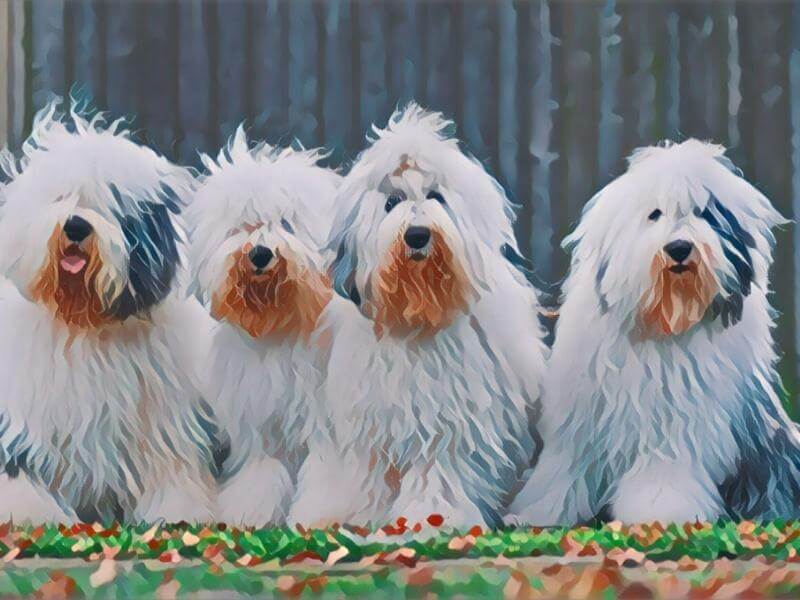
The Old English Sheepdog was initially bred in England as a drover dog in the late 18th century. These huge fluffy dogs were great family dogs and made excellent working dogs.
They used to crop the tail of the Sheepdogs that were working dogs to keep them out from under the horse’s hooves, the wheels of carriages or carts, and to indicate it was a working dog.
Some farmers used them as sheep herding dogs. They would shave the dog’s coats with the sheep, and the woman would use their fur along with the sheep’s wool to make clothes for the winter.
Standard Poodle
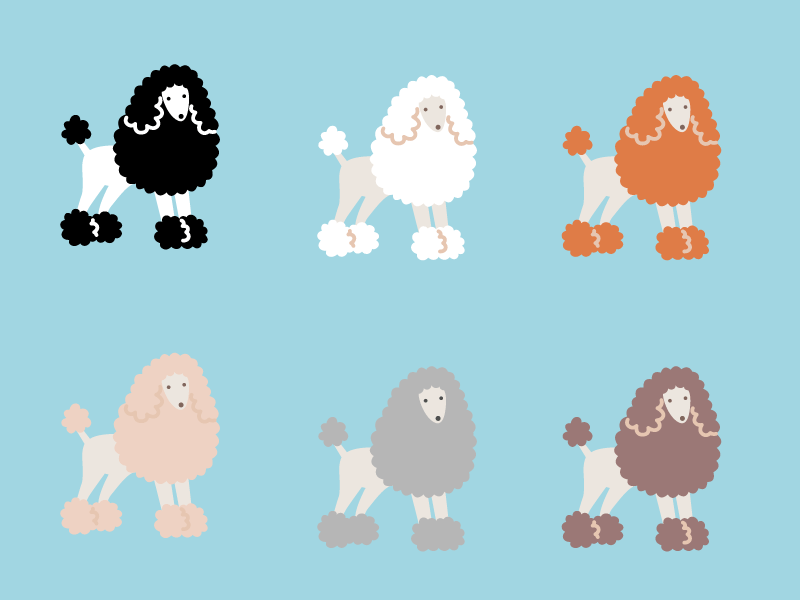
The Standard Poodle has its origins in Germany and France. They were bred as water retrievers when their owners went hunting. The breed gained attention when French royalty saw their intelligence and kept them as companion pets and hunting dogs.
They bred the Standard Poodle to the beautiful dog breed we know and love today.
The Standard Poodle was known to be a non-shedding dog even though their owners needed to groom them regularly to avoid matted, tangled fur.
They were also great as people with allergies could have a dog without having allergy flare-ups. They became highly popular as a symbol of wealth and prestige.
Appearance
Sheepadoodles are usually large dogs with fluffy coats of fur. Their facial features can lean towards either the long dome-shaped head of a Poodle or the more square-shaped head of the Old English Sheepdog. They have long, lean legs and floppy ears.
With time breeders realized they need their tail length to keep them better balanced, so tail cropping is a thing of the past.
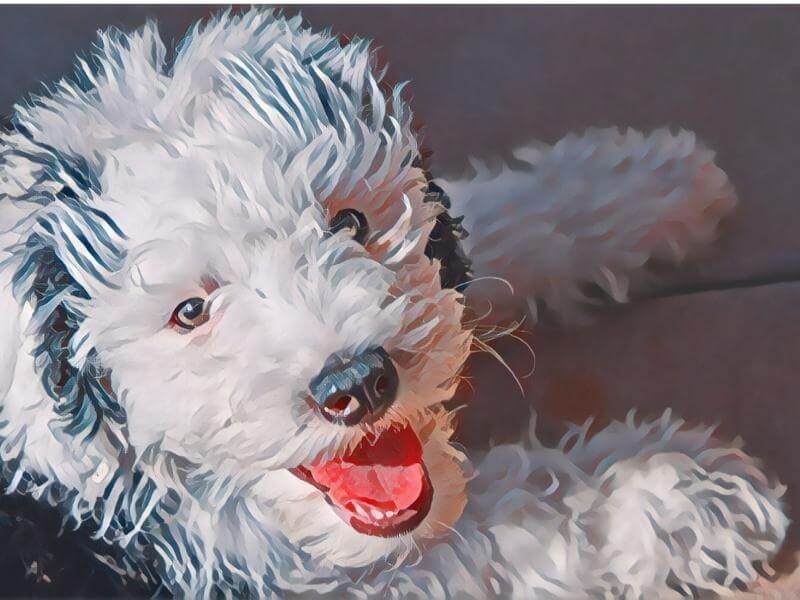
Coat Type
Sheepadoodles can have a low to non-shedding coat, so you won’t need to clean up tons of hair. They can have straight or wavy hair that is quite dense, like the Old English Sheepdog.
These thick coats come from the Old English Sheepdog side as they needed to have thicker coats to survive cold winters. Consequently, they can have wiry thick coats or the thinner curls that’re common to their Poodle parent.
Colors
Unlike other breeds, Sheepadoodles don’t come in many colors. They usually have coats that are:
- Black: Solid black that might fade to grey silver as they age.
- Black and white: Black with white patches or white with black patches.
- Brown and white: Brown and white is the rarest color you can find in Sheepadoodles.
Sizes
When Sheepadoodles became more popular, breeders saw that dog lovers wanted smaller dogs that looked like the standard Sheepadoodle.
So they decided to breed Old English Sheepdogs with different sizes of Poodles such as the Miniature Poodle and the Toy Poodle. This is how medium-sized and Mini Sheepadoodles came to be.
Standard
There are medium and large standard-sized Sheepadoodles. The medium-sized Sheepadoodles can weigh between 45-65 pounds and grow between 22-24 inches in height, depending on what side of the gene pool the dog gets most of its traits.
Medium
The medium-sized Sheepadoodle can weigh between 60-80 pounds and grow between 15-24 inches tall.
This depends on generation and the specific breed used for the mom and dad.
Mini
The Miniature Sheepadoodle is when breeders cross-breed a Toy Poodle with an Old English Sheepdog. They can weigh between 10-24 pounds and grow between 14-16 inches tall.
Micro
I was in disbelief when I found out that Micro Sheepadoodles were a thing. Surely, there is no way a big Sheepdog could be bred down into a toy or micro size.
According to a Micro Sheepadoodle owner, a Micro Sheepadoodle is a mix between a Mini Sheepadoodle and a Toy Poodle.
Using the size of a Toy Poodle, it is likely they will grow to no more than 10 inches in height and weigh less than 10 pounds.
Temperament
Generally, Sheepadoodle owners describe them as having a loyal and loving nature. They are great family dogs but do well with a single owner. They tend to get very attached to their owner and suffer from separation anxiety.
While they are friendly, Sheepadoodles are protective of their owners and make good guard dogs. If they have inherited more genes from the Old English Sheepdog, they might have drover instincts and need regular exercise to work off the excess energy.
They are great with young children and love to play, making them a joy for every family member.
Traits and Characteristics
The following infographic is a visual summary of the different traits of the Old English Sheepdog Poodle mix. All data was taken from the American Kennel Club.

Health Problems
Hybrid dogs (a cross between two purebred dogs) benefit from a decreased risk in inheriting breed-specific diseases. They tend to be healthier than standard purebred dogs.
There are a few medical conditions that Sheepadoodles are at risk for:
- Hip dysplasia: The gradual deteoriation of the hip joints, causing them to loosen and leading to pain and the hip joints not functioning correctly.
- Sebaceous adenitis: an inflammatory skin condition that can be aggravating and painful.
- Bloating: this could put pressure on the organs and disrupt their body’s normal blood flow.
- Diabetes: A blood sugar disease that requires medication and a proper diet.
- Addison’s Disease: This is when your dog’s adrenal glands can produce corticosteroid hormones, this can be treated with medication if caught early.
- Deafness
- Glaucoma
- Entropion
- Red Mange
Training
You need to train Sheepadoodles and set boundaries early on. Therefore if you are a first-time dog owner and are unsure how to prepare your Sheepadoodle, you may have a pup that nips when it wants to get its way, which can become a problem when they are older.
Starting a dedicated training plan at an early age will help avoid any unwanted behaviors to develop as they get older. Positive reinforcement training is a great avenue to pursue to help teach your puppy how to be a good, obedient doggo. It worked wonders for my Bernedoodle!
Price
The price of a Sheepadoodle will depend on whether you want to adopt or buy from a breeder. Some Sheepadoodles have ended up in shelters, so if you are looking for one, you can try adopting from a shelter first; adopting a dog can cost between $75-$200.
If you want to buy a Sheepadoodle puppy from a breeder, you can expect to pay between $900 and $2500. When you buy a Sheepadoodle, please ensure you buy from a reputable breeder and insist on a vet check to scan for genetic and other health issues.
Due to their relatively quick rise in popularity, Sheepadoodle breeders can be found all across the United States.
Testimonials
Below is a round up of what four different Sheepadoodle owners had to say about their doggos:
- “We have 5 dogs and he’s the first dog I’ve ever had not to teeth on me . . . easy to teach commands and super loving”
- “[Referencing their F1b Reverse Sheepadoodle] He is the most loving being I’ve ever met. We started therapy dog training . . . His trainer said that he was extraordinary and will be a legend”
- “Sheepadoodles are the best! Ours does bark… at everything lol. But she is truly is amazing, smart, and is always ready for a long walk or play at the dog park.”
- “Our Sheepadoodle is the best dog we ever had because she is eager to please, super affectionate, playful, smart, a quick learner, non destructive, sleeps through the night without bothering us, rings a bell to go potty outside and does not shed hair at all. What more can one ask from a dog? I just wish I had a second one.”
Fun Facts About Sheepadoodles
Here are some of the most fun and exciting facts about Sheepadoodles I bet you didn’t know:
- There is a Sheepadoodle on TikTok named Bunny that uses button-speech to “talk” to her owners. She is known for her funny interactions, conversations, and reactions to her owners and has gained thousands of followers.
- Olympic figure skater Meryl Davis and Fedor Andreev adopted a Mini Sheepadoodle called Bilbo, bringing new attention to this lovable hybrid breed.
- While they aren’t barkers, they are very vocal and sassy dogs that will let you know how they feel.
- A Sheepadoodle called Zammy worked as a therapy dog in a children’s hospital. His funny antics and lovable nature has made him a social media star.
- Sheepadoodles are easy to potty train and won’t take longer than a week to learn something new.
FAQs
Below are some frequently asked questions about Sheepadoodles.
What are the different generations of a Sheepadoodle?
Like all Doodle breeds, there are different generations of Sheepadoodles:
- F1 (first generation): F1 Sheepadoodles are the offspring of a purebred Old English Sheepdog and a Standard Poodle (50% Old English Sheepdog and 50% Standard Poodle).
- F1B (F1b): F1B Sheepadoodles are a cross-breed of an F1 Sheepadoodle and an Old English Sheepdog (25% Poodle and 75% Old English Sheepdog). They are back-crossed with an Old English Sheepdog hence the designation “B” or “b” in F1b.
- F1BB (F1bb): F1bb Sheepadoodles are a double backcross. This is where things get complicated. I can be a backcross between a Poodle followed by another Poodle backcross or vice versa using the Sheepdog.
- F2 (second generation): F2 Sheepadoodles are when two F1 Sheepadoodles are bred together.
- It is possible to have more generations besides F1 and F2 Sheepadoodle. These involve further backcrossing and selective breeding and are classified as F2b, F3, etc.
Are Sheepadoodles hard to train?
Sheepadoodles are highly trainable dogs, so you can get a trainer to help teach you more about your dog’s behavior. You must ensure the trainer you use is a reputable trainer that employs the correct (humane) methods such as positive reinforcement.
They want to please their owners, so having an obedient dog with training and patience.
Do Sheepadoodles lose their puppy fur?
Yes, like all dogs Sheepadoodles will lose their puppy fur. This process can start as early as 3 months of age or won’t start until they are one year old. Typically, most puppies will shed their puppy coat at the 4-to-6 month mark [2]www.akc.org/expert-advice/health/why-puppies-shed/.
Do Sheepadoodles like swimming?
Yes, Sheepadoodles like to swim. Poodles (their parent breed) are excellent swimmers and love the water. They were bred to be waterfowl retrievers. Old English Sheepdogs aren’t obsessed with water but they can be taught to swim. The combination of both parents, makes most Sheepadoodles attracted to swimming and water activities.
Are Sheepadoodles protective?
Yes, they can be protective of their family and territory. However, they are not aggressively protective like other breeds. Old English Sheepdogs have a herding instinct which makes them protective. Poodles are great watchdogs so the combination of the two traits gives the Sheepadoodle a protective nature.
At what age is a Sheepadoodle full grown?
A Sheepadoodle is fully grown between the ages of 2-3 years. This is based on the average between their parent breeds. Poodles generally are fully grown at the 2-year mark while Old English Sheepdogs reach their adult size around the 3 year mark [3]www.pawlicy.com/blog/poodle-growth-and-weight, [4]www.hillspet.com/dog-care/dog-breeds/old-english-sheepdog.
Does a Sheepadoodle bark?
Sheepadoodles are moderate barkers. They are by no means constant yappers but are not quiet either. They land right in the middle 50% on the barking scale, which means they will bark when they feel its necessary. Situations with strangers, new animals, or if they feel threatened will make them bark.
Are Sheepadoodle Coats High Maintenance?
Sheepadoodle coats are not hard to maintain. They will need to see a groomer at least once every eight weeks to get bathed, brushed, and shaved (if you choose to). If your Sheepadoodle has hair similar to the Old English Sheepdog parent and you live in a hot or humid climate, you might need to shave its fur.
They can overheat and dehydrate if you don’t shave them in hot climates. They can also develop skin issues if they are not groomed regularly. It would help if you also brushed their coats weekly to ensure their fur doesn’t get matted. Matted and tangled hair can be painful.
Do all Sheepadoodles look the same?
Not all Sheepadoodles look alike. Sheepadoodles from the same litter can differ in appearance, depending on what parent their gene pool leans toward. They can be lean with long legs and have different hair textures like the standard poodles.
They can have broad shoulders and a bulky build with lush wiry hair if they lean more towards the Old English Sheepdog side. Sheepadoodles mostly have the same colors, even with different hair textures and general looks.
How fast can Sheepadoodles run?
Shockingly, Sheepadoodles are considered fast dogs. The Sheepadoodle’s long legs allow them to run at top speeds of between 30-48kph. There is no reliable data on their average rate, but their heritage makes them faster than other dogs of their size.
Are Sheepadoodles droolers?
Usually, big dog breeds tend to drool a lot, but surprisingly Sheepadoodles are not among them. They rarely drool, although their mouths can stay wet after drinking water as it clings to their beard.
How long do Sheepadoodles live?
They have an average lifespan of between 12-15 years.
Conclusion
Sheepadoodles are big and fluffy loving dogs. They are attuned to the emotions of the humans around them, which makes them the perfect dog to use as emotional support and therapy dogs. Additionally, they are great for allergy sufferers because of their low to non-shedding coats.
After reading this guide, now you are ready to go pick out a Sheepadoodle puppy!
If you are interested in other Poodle-mixes, you should take a look at my in-depth guide to Doodle breeds.


